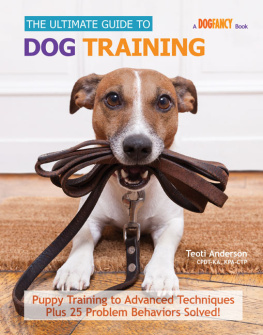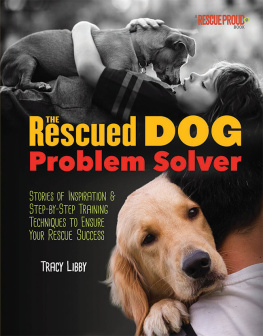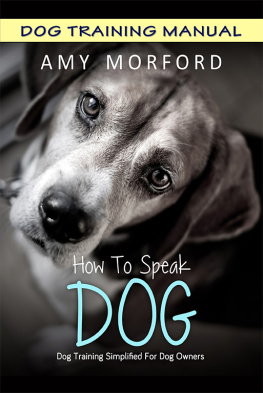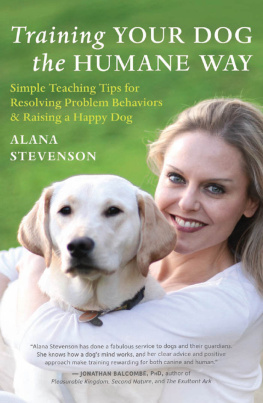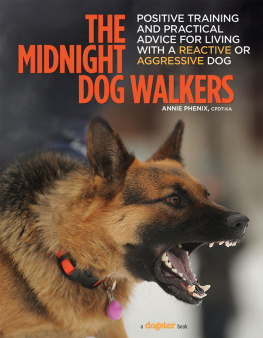Part I: A LOOK AT BEHAVIOR AND TRAINING
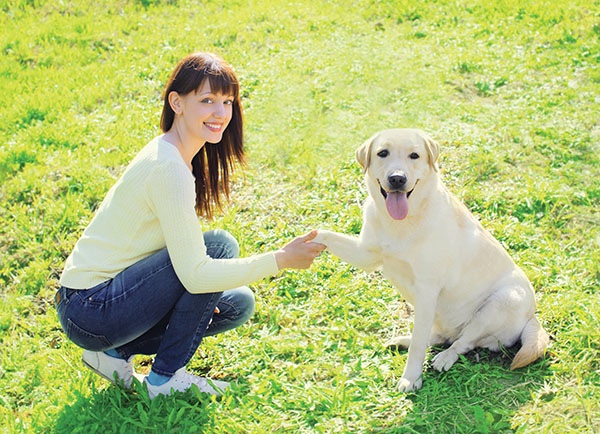
Trust between owner and dog is an all-important essential.
You do NOT remember signing up for this. You distinctly remember the original dream. You wanted to add a dog to your family. You wanted a furry friend to love you no matter what. You wanted a sweet, loving companionsmart, friendly, and well-behaved enough to take anywhere. It was supposed to be perfect. It was going to be fun. It probably started out that way. But somewhere along the way, your dream of the perfect pet faded. Youre waking up to the fact your dog has some problems. And now youre getting worried.
What happened? You know other people who have dogs like yours, and their dogs seem just fine. Your coworkers often laughingly share stories about their dogs funny antics. You have relatives who brag about their dogs accomplishments. Maybe youve had dogs before who were so easy to live with. Why did this dog turn out differently? How did living with an adorable, beautiful dog turn into such a hassle? Is your dog just broken? More importantly, can you fix him?
Youre not alone, even though it surely feels like it sometimes. Please dont despair. You already made the decision to help your dog, and thats a positive step!
Dog Differences
Any time you bring a different species into your home, youre going to encounter challenges. You see the world very differently from the way your canine friend does. You certainly have different distractions. You have better sight, he has better senses of smell and hearing. The way you perceive the world around you affects your actions in it. For example, you might be distracted by the sight of a friend in the distance, while your dog becomes obsessed with the scent of a steak grilling two blocks away.
You process information differently as well. People primarily communicate verbally, while dogs are much more adept at reading and signaling through body language. Humans are capable of saying one thing while meaning another, while dogs are unfailingly honest creatures. You always know where you stand with a dog. People, not so much. Is there any wonder miscommunication occurs?
You have different priorities. You may be obsessing over a business deadline while your dog lives for you tossing him a tennis ball. Dogs also have different skill sets than we do skills that involve chewing, pulling, jumping, digging, and other behaviors. We adore dogs for what they are while at the same time getting annoyed at what they do. Sometimes problem behaviors are minor. Sometimes they are quite serious.
Studies have shown that behavioral problems are a top reason why people relinquish their dogs to shelters and other rescue organizations. Common problems cited include aggression toward people and other pets, a tendency to escape, destructiveness indoors and outdoors, hyperactivity, house soiling, and disobedience. This doesnt mean that all shelter dogs have problems. Far from the case! There are other reasons for relinquishment, such as people moving and unable or unwilling to take a dog with them, divorces, deaths in the family, lack of money to care for a dog adequately, and more. But behavioral problems frequently top the list.
Some people get in over their heads with a dog who has problem behaviors. Sometimes, a dogs problem is much more than his owner bargained for, while other times people make the mistake of not doing their research before bringing a dog into the home. Whatever the motive, the fact that behavioral reasons are a prime reason for relinquishment should tell you that problem behaviors are fairly common with our canine friends. Dont be fooled by all those perfect dog stories you compare your dog to it may be that you just hear the nice Fido stories and not the naughty ones!
Just because your dog has a problem behavior does not make him defective. Each and every dog has a unique personality and individual characteristics all of his own. Hes one of a kind. Your dog just happens to have some problem issues you need to address. It also doesnt mean that youre crazy for loving him. He may pose challenges, but hes still the fluffy bundle of joy you brought home. There was a reason why you chose this dog. There was something about his spirit his eyes the way he interacted with you that spoke to your heart. Hes taken up residence there now, even though he does try your patience.
So what do you do about it? Take positive steps to figure out what is contributing to your dogs behavior and how to address his specific issues.
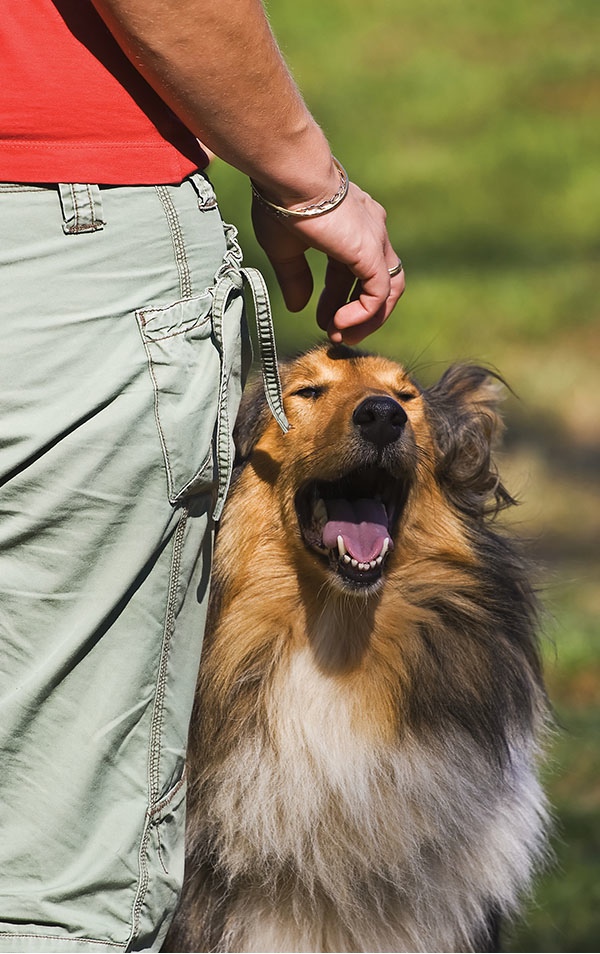
With time, patience and training, you can have a well-behaved dog.
8: Chewing
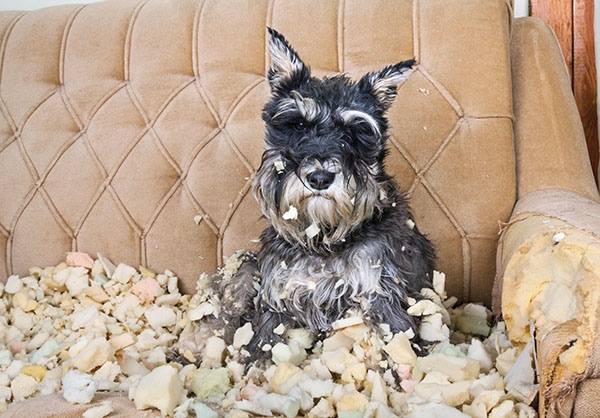
Dogs chew destructively for all kinds of reasons, including boredom, stress, and, in teething puppies, to relieve the pain of sore gums.
Youre the reason we cant have nice things! is a common exclamation in the Johnson household. The statement is always directed with a glare at Oscar, their 24-week-old Weimaraner. Even at this tender age, Oscar has managed to chew up an ottoman, the legs of three kitchen chairs, the lever on a recliner, three pairs of reading glasses, four beloved stuffed animals, half a dozen shoes, five socks, the corners of the kitchen cabinets, and an Adirondack chair. His family has bought him a ton of toys, so they are getting frustrated. Why doesnt Oscar chew those, instead? Theyre afraid hes just getting started. Theyre right!
Dogs can be extremely destructive with their chewing, especially as puppies. Some dogs outgrow it, but not all of them do. This can be extremely frustrating, especially when your dog chews something expensive or with sentimental value.
Symptoms
All dogs chew. It becomes a problem behaviordestructive chewingwhen your dog chews something you dont want him to chew. This can be furniture, rugs, shoes, your belongings, and more. Some dogs have even been known to chew holes in walls.
If it is related to separation anxiety, the chewing will be focused on doorways or other exit points. Some people mistake this for destructive chewing, but the location of the destruction will often indicate its really a separation anxiety-related problem.
Some dogs will even chew on themselves, causing self-injury.
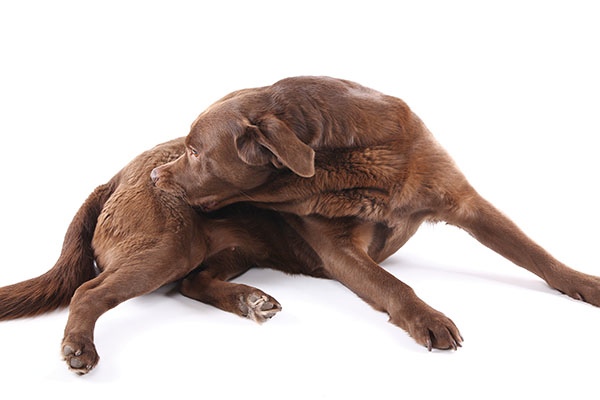
One reason a dog may chew at himself is to relieve an itch caused by mites or fleas.
Why It Happens
Dogs do not chew out of spite or because they are mad at you. There are many other and more practical reasons for why dogs chew.
Puppies start to lose their baby teeth at about 4 months of age. This is when you will see an acceleration in chewing behavior. Chewing feels good to a puppys sore gums. You may find baby teeth on the floor or stuck in a toy. Chewing may slow down after the puppy teeth fall out, but it will soon kick in again. At about 7 months, a dogs back molars will come in, so dogs will start chewing again to soothe their gums.
Dogs also chew because its fun. They can chew when they are bored. They can also chew to relieve stress. If your dog is frightened of thunderstorms and there is a storm while you are at work, you may come home to a dog who has chewed his way through the house. Chewing helps a dog relieve his stress.
If a dog has separation anxiety, he will do just about anything to escape confinement. This can mean chewing through a crate or even a door. You may also notice destruction around windows or other exit routes.
Next page


